Chandrasekaran A. (ed.) Current Trends in X-Ray Crystallography
Подождите немного. Документ загружается.

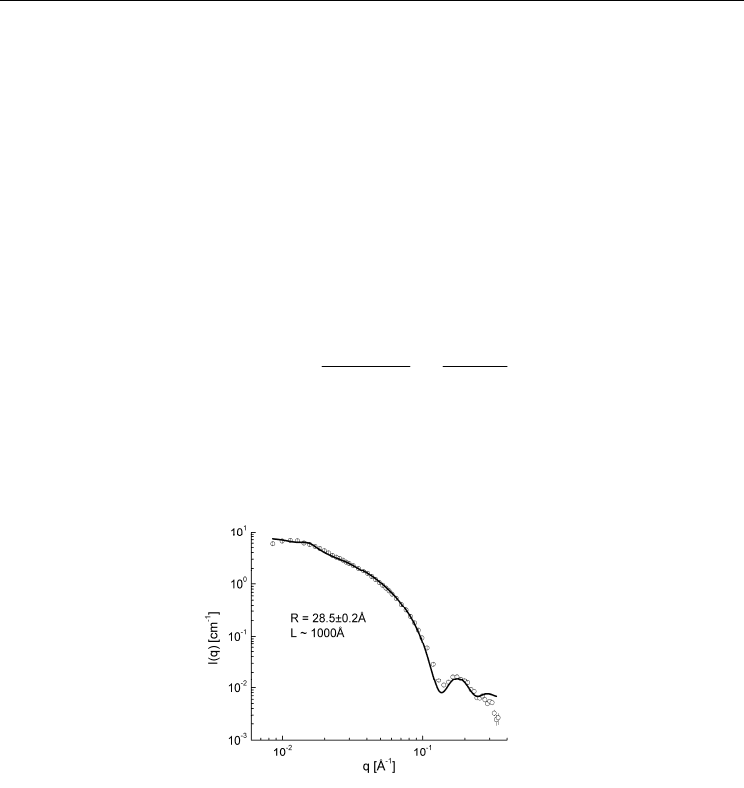
Investigating Macromolecular Complexes in Solution by Small Angle X-Ray Scattering
377
several reviews (Pedersen, 1997). Also, advanced modeling approaches can be found in
specialized articles in the literature (Székely et al, 2010).
The main advantage of the use of analytical or semi analytical expressions describing the
form factor is that, usually, there is a low number of parameters to adjust against
experimental data, permitting the determination of structural information with reasonable
reliability. Also, if the model does not fit the data correctly, this directly indicates that the
particle shape is different from the one that is been assumed. One example of application si
presented in Fig8 where the model of an elongated cylinder was used to described the SAXS
data of mature glucagon fibers. In several cases, the particle possible shape is known but
the calculations of the integrals is impractical. In these cases it is possible to use the finite
element method which consists of build up the particle shape using known subunits. One
approach is to use spherical subunits and apply the Debye formula to calculate the intensity
(Debye, 1915; Glatter, 1980):
2
1
2
,1
sin
,
N
i
j
bead
Model
ij
ij
qr
fqr
Pq
qr
N
(18)
This procedure enables the calculation of very complicated models. From this calculation
the model parameters can be optimized against experimental data (Oliveira et all, 2009,
2010).
Fig. 8. Example of application of the use of a known form factor . Experimental data (open
circles) of a mature fiber of Glucagon (Oliveira et al, 2009) and the theoretical fit (solid line),
assuming a form factor of cylinders, with radius R and length L. The SAXS data was
measured at the laboratory SAXS instrument Nanostar
TM
, from Professor Jan Skov Pedersen
at University of Aarhus, Denmark.
2.2.3 Deconvolution square root – obtaining the electron density profile
In some applications, the particle shape is known but the electron density profile and overall
dimensions have to be determined. Amphifilic molecules like surfactants and several types
of diblock copolymers self assemble into structures that can be analyzed in this way. Several
propositions for the deconvolution square root procedure can be found in the literature
(Pape and Kreutz, 1978; Nagle and Wierner, 1989). An initial approach was to take the
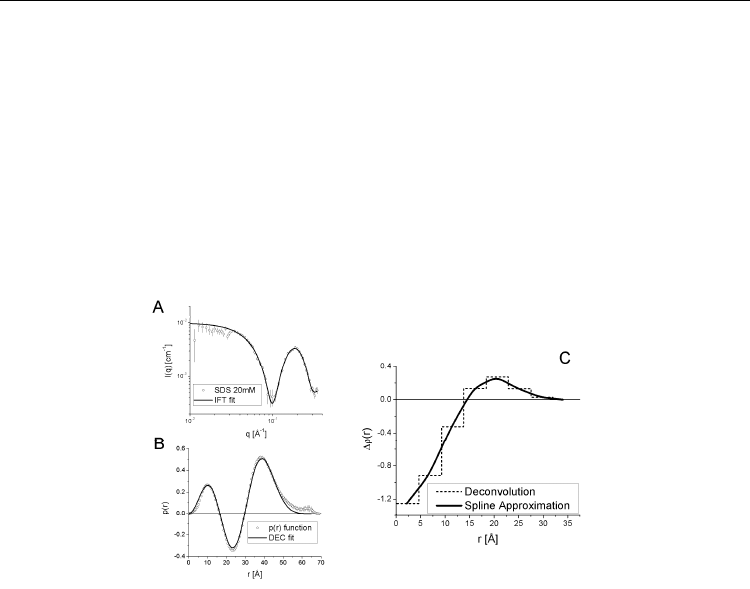
Current Trends in X-Ray Crystallography
378
square root of the scattering intensity, which gives an absolute value for the amplitude
function f(q). Then, by Fourier transforming this function is possible to retrieve the electron
density distribution
(r). This procedure has serious problems since the signals of the f(q)
function has to be guessed an also the very short interval of data on reciprocal space
precludes a trustful calculation of the inverse Fourier transformation. A more stable process
was proposed by Glatter (Glatter 1981; Glatter 1984, Bergmann et al, 2000) where the
deconvolution is made by the use of the p(r) function. Apart of the overall sign of the
electron density profile (1 factor), this procedure enables a correct estimation of the
electron density profile, and has been used in several applications (Rathgeber et al, 2002).
One example of application of this method is presented in Fig9, where the radial electron
density of SDS micelles could be obtained.
Fig. 9. Example of application of the deconvolution method. A) Experimental SDS data
(open circles) and the IFT fit (solid line). B) IFT Calculated p(r) function (open circles) and
the theoretical p(r) obtained from the deconvolution method (solid line). C) Restored radial
electron density profile presented as step functions (dashed line) and by the use of a smooth
approximation (solid line). The SAXS data was measured at the laboratory SAXS instrument
Nanostar
TM
, from Professor Jan Skov Pedersen at University of Aarhus, Denmark.
2.2.4 Ab initio modeling – an overview
The shape of the scattering function is directly related to the three-dimensional shape of the
particle. However, since the particles are randomly oriented (equation 6) and there is only a
limited measurable region in reciprocal space, the information content in a SAXS curve is
very low (Patel and Schimidt, 1971). Nevertheless, even with these limitations important
developments occurred in the last decades have proof that it is possible to obtain a 3D
model from the 1D SAXS curves. Starting from the seminal work from Sturhmann in late
70’s (Sturhmann, 1973; Sturhmann and Miller, 1978), Svergun and co-workers had used a set
of spherical harmonics (multipolar expansion) to describe the particle electron density and
by the use of a nonlinear minimization procedure it is possible to obtain the set of spherical
harmonics coefficients that gives the best fit of the scattering data. Details on the calculations
and the representation of the scattering intensity using spherical harmonics can be found in
the original articles (Svergun and Sturhmann, 1991). The success of this method has shown
that, even though it is not possible to obtain a unique solution for the particle shape, the
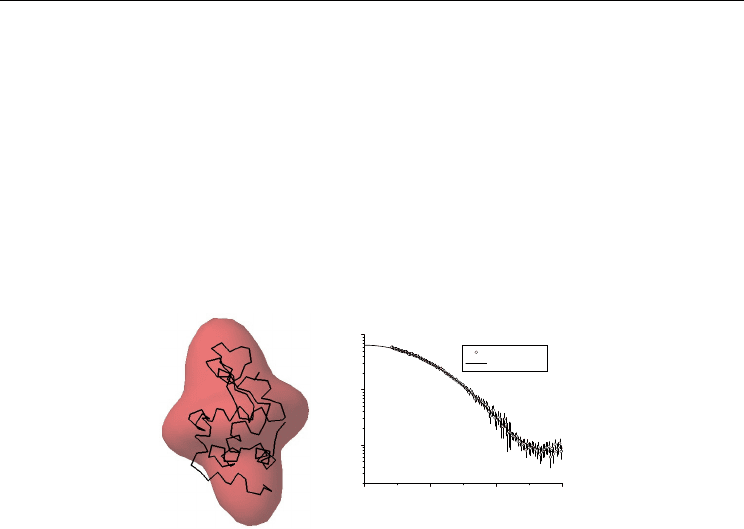
Investigating Macromolecular Complexes in Solution by Small Angle X-Ray Scattering
379
fitting of the experimental scattering data enabled a direct ab initio determination of the
three-dimensional shape. Since the representation using spherical harmonics only enables
the construction of smooth shapes without sharp edges or corners, this approach provides a
rough representation of the particle shape. In this way it can be said that this method
provides a very low resolution approximation of the scattering data and usually enables the
fitting of only the initial part of the scattering intensity. Program packages that enables the
fitting of experimental data are available in the literature (programs ASSA and SASHA,
Kozin et al, 1997). An example of this procedure is shown in fig10 where the experimental
data for lysozime in solution was adjusted using multipolar expansion by using the
program SASHA. It can be directly seen that the correct anisotropy and overall shape can be
obtained from this approach. In all the examples shown in figures 10-14 the measurements
were performed in the SAXS beamline of Brazilian Synchrotron Light Laboratory.
0.0 0.1 0.2 0.3
10
-1
10
0
10
1
I(q) [arb. u.]
q [Å
-1
]
Experimental
Model Fit
Fig. 10. Ab initio modeling of experimental SAXS data using multipolar expansion. Left: on
red it is shown the model obtained superposed with the backbone of the protein obtained
from its known crystallographic structure (pdb entry 6lyz.pdb). Right: Fit of experimental
data. Open circles – experimental data. Solid line – model fit.
A further improvement on the ab initio procedure for modeling SAXS data was proposed
initially by Chacón (program DALAI, Chacón et al, 1998), and later by Svergun (Program
DAMMIN, Svergun, 1999), Doniach (program SAXS3D, Walter et al, 2000) among others. In
this method the particle is build using the finite element approach, by the use of a closed
packing arrangement of spherical subunits. Since the number of possible solutions is very
large, Monte Carlo based optimization methods are used to obtain the set of spherical
subunits that gives the best fitting of the scattering data. The program DAMMIN is widely
cited in the literature and starts by creating a spherical search space with diameter equal or
slightly larger than the particle maximum diameter D
MAX
(obtained from the p(r) curve). By
the application of a simulated annealing procedure, constrained by penalty functions that
ensure particle compactness and smoothness (Volkov and Svergun, 2002), a subset of the
initial search space can be obtained providing a three-dimensional model that represents the
particle shape. Due to the intrinsic randomness of Monte Carlo approaches, several
independent runs of these model procedures will lead to different models. However, it is
possible to show that all models might share similar features like overall anisotropy, size,
etc. This model approach permits a better representation of the particle shape than the
multipolar expansion since it does not have the above mentioned limitations for the shape
description. However, since the internal structure is not represented, this method cannot
describe data up to high q values (Volkov and Svergun, 2002). One example of this so called
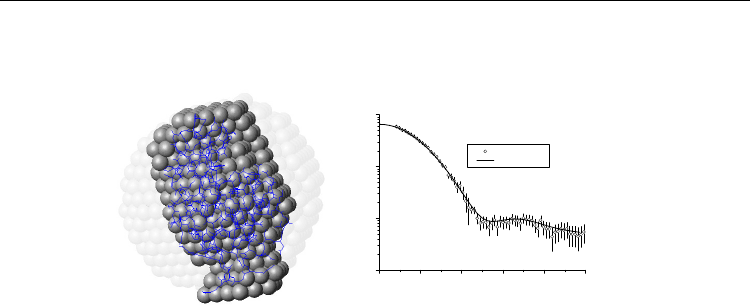
Current Trends in X-Ray Crystallography
380
“dummy atom modeling” is shown in Fig11 where the ab initio model was obtained from
SAXS data of lysozyme in solution.
0.0 0.1 0.2 0.3 0.4 0.5
10
-2
10
-1
10
0
10
1
I(q) [arb. u.]
q [Å
-1
]
Experimental
Model Fit
Fig. 11. Ab initio modeling of experimental SAXS data using dummy atom modeling. Left:
model results. Semitransparent spheres – initial search space. Solid spheres – selected subset
that gives the best fit. Blue backbone – protein backbone obtained from its known
crystallographic structure (pdb entry 6lyz.pdb). Right: Fit of experimental data. Open circles
– experimental data. Solid line – model fit.
When dealing with SAXS data from proteins, one additional very useful constraint can be
used for the model building. Proteins are composed of a sequence of aminoacids, which
forms its backbone, known as primary structure. This primary sequence folds into specific
patterns like -helices, -sheets, turns, etc, composing the secondary structure. Finally, the
secondary structure folds into a specific three-dimensional arrangement, known as tertiary
structure. In some cases this protein can even be part of a supramolecular complex which
comprises the quaternary structure (Voet et al, 2008). Due to the intrinsic low resolution and
information of a SAXS data, the information about the atomic resolution structure or
secondary structure cannot be accessed but instead, the overall shape and size. However,
the information of sequence continuity can be used as a constraint to enable a better
modeling of proteins in solution. This procedure was implemented by Svergun, Pethoukov
and co-workerks in the “dummy chain model” approach (Program GASBOR, Svergun et al,
2001). In this method a sequence of interconnected chains is used to represent the protein
backbone. Each sphere corresponds to one amino acid and therefore the total number of
spheres is identical to the number of protein residues. Starting from a spherical arrangement
of the backbone the optimization program performs a simulated annealing optimization in
which the backbone three-dimensional arrangement is changed in order to provide the best
fitting of the scattering data. Similarly to the dummy atom approach, the theoretical
intensity is calculated using a variation of the Debye formula (equation 18). The natural
constraint imposed by the continuity of the backbone makes leads to better representations
of protein structures. Also, this approach can fit experimental data up to higher q values
than the previous ones since the internal structure of the protein is somehow represented by
the backbone. One example of this so called “dummy chain modeling” is shown in Fig12
where the ab initio model was obtained from SAXS data of lysozyme in solution.
The previous examples showed the possibility of apply ab initio methods to retrieve the
three-dimensional structure. Although the model results for the dummy atom and dummy
chain methods are not unique due to the heuristic nature of the optimization methods, the
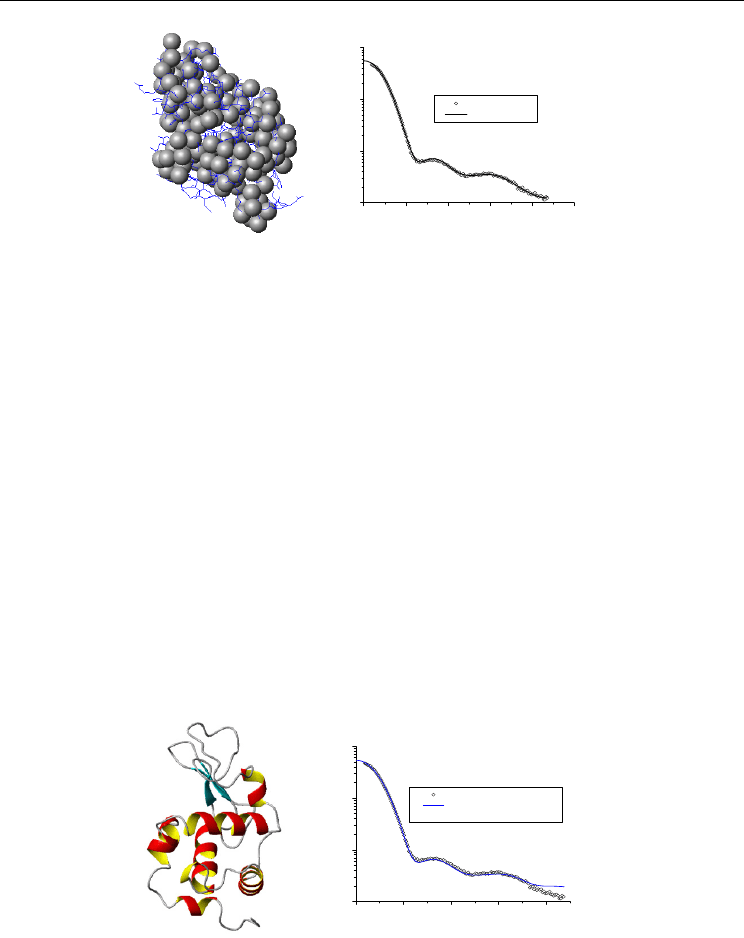
Investigating Macromolecular Complexes in Solution by Small Angle X-Ray Scattering
381
0.00.20.40.60.81.0
10
-5
10
-4
10
-3
10
-2
I(q) [arb. u.]
q [Å
-1
]
Experimental
Model Fit
Fig. 12. Ab initio modeling of experimental SAXS data using dummy chain modeling. Left:
optimized backbone structure (solid spheres) superimposed by the backbone obtained from
the protein known crystallographic structure (pdb entry 6lyz.pdb). Right: Fit of experimental
data. Open circles – experimental data. Solid line – model fit.
overall size, shape and anisotropy can be obtained from these approaches. Another very
useful application of the study of proteins in solution is the use of known atomic resolution
data in connection with SAXS data. If the full atomic model for the protein is known, the
comparison of the theoretical scattering intensity against experimental data provides direct
information about the conformation of the protein in solution in comparison with the atomic
resolution structure. A good fit indicates that the structure of the protein in solution is
similar to the given by the atomic resolution model. Discrepancies in the fit indicate
differences between the atomic resolution model and the protein structure in solution. A
widely cited procedure that enabled a successful comparison between experimental data
and atomic resolution structures was developed by Svergun and co-workers (program
CRYSOL, Svergun et al, 1995) where it was demonstrated that a hydration shell around the
protein with slightly higher electron density than the one from the bulk was necessary to be
considered. One example of this comparison between experimental data and theoretical
SAXS intensity calculated from atomic coordinates is shown in Fig13 where the
crystallographic structure for the protein lysozyme was used for the comparison with
experimental data of lysozyme in solution.
0.0 0.2 0.4 0.6 0.8
10
-5
10
-4
10
-3
10
-2
I(q) [arb. u.]
q [Å
-1
]
Experimental
Intensity calculated from
Crystal Structure
Fig. 13. Ab initio modeling of experimental SAXS data using dummy chain modeling. Left:
representation of the crystallographic structure of lysozyme (pdb entry 6lyz.pdb). Right: Fit
of experimental data. Open circles – experimental data. Solid line – theoretical fit.
One of the major applicability of the use of SAXS data and the knowledge about atomic
resolution models for proteins is for the cases where just part of the structure is known. In
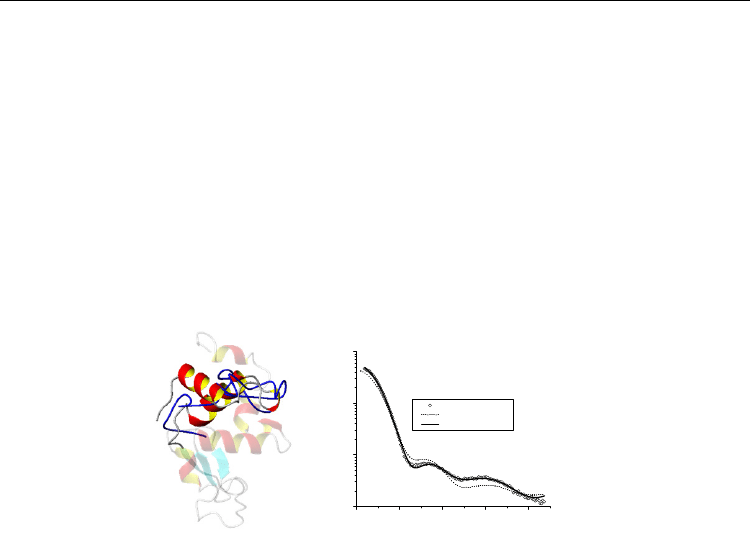
Current Trends in X-Ray Crystallography
382
these situations the SAXS data can be used to generate (using the dummy chain approach)
the missing aminoacid loops in the known structure (program BUNCH, Petoukhov and
Svergun, 2005) or/and to obtain the spatial arrangement of known domains in order to form
the full structure (program SASREF, Petoukhov and Svergun, 2005). Both the generation of
the missing loops and the optimization of domains are performed by the use of Monte Carlo
methods which, similarly to the previous cases, do not lead to a unique solution. However,
even though the solution is not unique, the obtained model is a very good representation of
the overall structure. Test examples are shown in Fig14 and Fig15. In Fig14 part of the
lysozyme structure was clipped and as it can be seen in the curve, without the loop the
atomic model cannot fit the experimental data correctly. With the addition of a dummy
chain loop and its optimization it is possible to obtain a very good fit of the experimental
data. The generated loop (blue loop in the model) is a reasonable approximation of the real
loop superposed to it.
0.0 0.2 0.4 0.6 0.8
10
-5
10
-4
10
-3
10
-2
I(q) [arb. u.]
q [Å
-1
]
Experimental
Fit without the loop
Final model
Fig. 14. Ab initio modeling of missing loop of a hypothetical structure using experimental
SAXS data. Left: crystallographic structure of lysozyme (pdb entry 6lyz.pdb) and the restored
loop. Semitransparent structure – lysozyme structure with a missing part. Blue blackbone –
restored loop superposed to the real, clipped loop. Right: Fit of the experimental data. Open
circles – experimental SAXS data for lysozyme in solution. Dotted line – fitting of the
scattering data for the structure without the loop. Solid line – fitting of the scattering data
for the structure with the optimized loop.
In Fig15 a hypothetical situation of a heterodimer is shown. The optimization of the
structure components does not give a perfect agreement with the initial structural but there
is a remarkable similarity, indicating that SAXS data can also be applied in these cases.
The situations presented here are just a small representation of possibilities for the
applications of these modeling tools. Advanced modeling examples based on these
procedures can be found in several articles in the literature (Svergun, 2007). An intrinsic
problem of any SAXS modeling is the ambiguity that might arises in the results. In general,
it is not possible to obtain a unique solution from the modeling procedure. Therefore it is
necessary to complement any scattering modeling with additional information in order to
reduce the number of possible solutions. There are several ways on doing this. When
available, information about binding sites or specific arrangement of domains can be used as
constraints in the modeling. Results from biochemical/biophysical techniques can provide
useful information about structure change or binding. For example, fluorescence
spectroscopy and isothermal titration calorimetry can provide important information on
binding and stoichiometry. In recent applications the simultaneous modeling of scattering
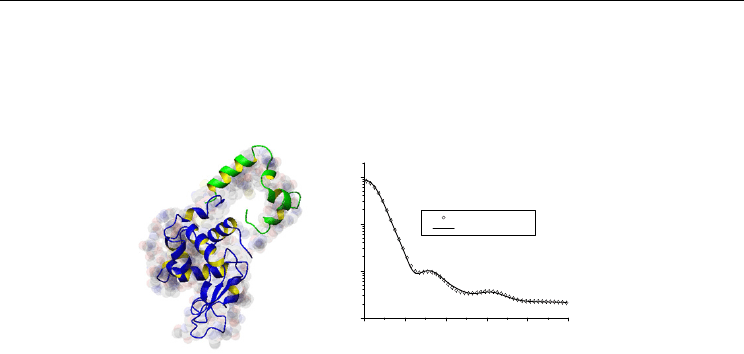
Investigating Macromolecular Complexes in Solution by Small Angle X-Ray Scattering
383
data and other experimental data is been tried. A simultaneous modeling of SAXS and NRM
data was proposed by Mareuil and co-workers in the program DADIMODO (Mareiul et al,
2007). Also, automatic tools for the use of complementarity between SAXS and NMR is been
currently developed in connection with the SAXIER project (Svergun, 2007; Svergun, 2009).
0.0 0.2 0.4 0.6 0.8 1.0
10
-1
10
0
10
1
10
2
I(q) [arb. u.]
q [Å
-1
]
Generated Data
Final model
Fig. 15. Rigid body modeling of a hypothetical structure using calculated SAXS data. Left:
hypothetical heterodimer built using two atomic resolution structures. Semitransparent
spheres: original structure. Blue and green strands: optimized heterodimer. Right: Fit of the
generated data. Open circles – generated SAXS data for the heterodimer. The data was
created using program CRYSOL from the built model. Standard deviations were added in
order to mimic experimental uncertainties. Solid line – fitting of the scattering data for the
optimized structure.
3. Applications
Two applications of SAXS analysis will be presented. In the first case, an in-situ aggregation
study of lysozyme is presented. As a second example a structural characterization of a giant
protein complex is described. These two cases are good examples of the application of the
SAXS technique to investigate biological systems.
3.1 Lysozyme denaturation and aggregation induced by heat
The structure of proteins is intrinsically related to its shape. The protein shape, on the other
hand, is a result of the protein folding. In the native state, proteins are known to adopt
hierarchical structures, which might be a result of a multistep folding process. One possible
way to investigate this characteristic is to induce protein denaturation. The denaturation or
unfolding can be induced by changes in temperature, pH, or even by the addition of
denaturant agents like sodium dodecyl sulfate (SDS). A study of denaturation induced by
heat will be presented here.
The experiments were performed at the SAXS beamline of the Brazilian Synchrotron Light
Laboratory, Campinas, Brazil. The wavelength selected for the experiments was λ =1.49 Å
and the distance between the sample and detector was 745 mm. The measurements were
performed using a 1D Gabriel-type detector. The samples were exposed in a 1.5mm
capillary tube in a thermally controlled sample holder directly connected to the evacuated
beam path. These experiments were performed with lysozyme samples at 10 mg/mL and
pH 7.0 in a 10mM phosphate buffer with 50mM of NaCl. Indirect Fourier transformations
were performed using program package GNOM which enabled the correction of smearing
effects. Ab initio models were built using program DAMMIN.
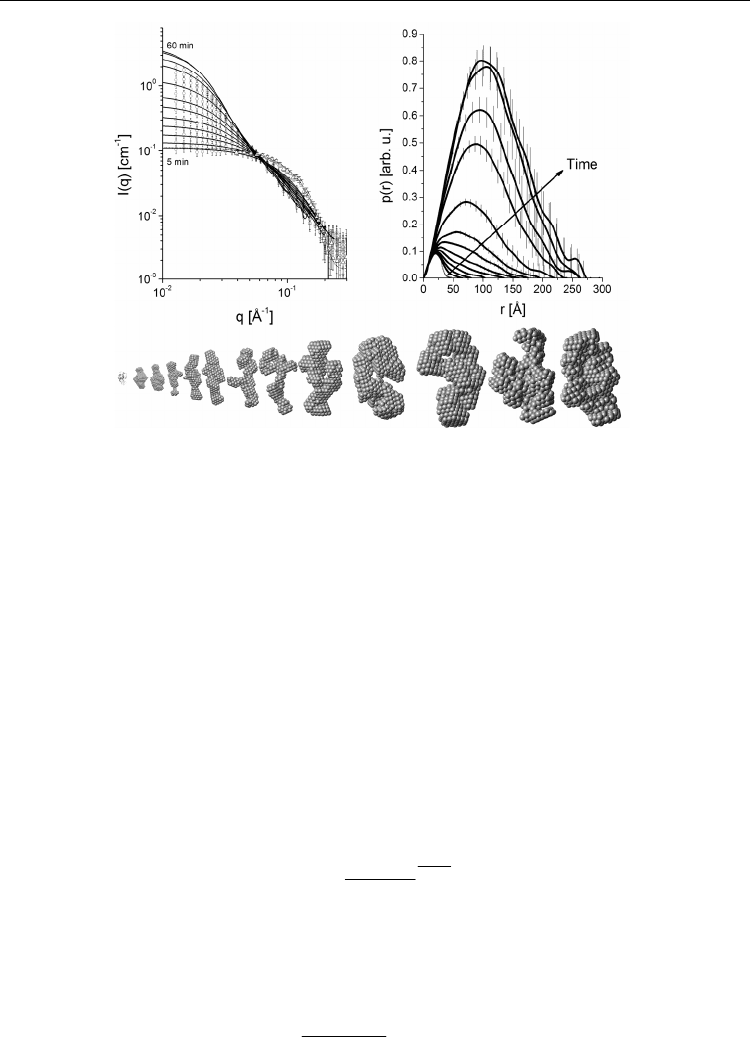
Current Trends in X-Ray Crystallography
384
Fig. 16. Aggregation of Lysozyme induced by heat. Top left: scattering data (open circles)
and desmeared IFT fits (solid lines). The frames were collected at 80
o
C in intervals of 5
minutes (first-5min, last-60min). A frame of lysozyme at room temperature (open triangles
and dotted line) was added for comparison. Top right: pair distance distribution functions
p(r) for each dataset. A frame obtained from the SAXS data for lysozyme at room
temperature (dotted line) was added for comparison. Bottom: Ab initio models restored for
each frame. It is possible to see the increase in size for the average model. For comparison,
the crystal structure of lysozyme is shown on the left as ribbons.
The results are shown in Fig16. As can be seen, when the protein solution is subjected to
80ºC an evolution of the SAXS profiles as a function of time is observed. As shown in
equation 13 and 14, the forward scattering I(0) can provide an estimation for the molecular
weight. For a system that presents the formation of aggregates over time, the obtained
molecular weight will be an averaged value since a distribution of sizes can be present in the
system. However, because the forward scattering is proportional to the square of the particle
volume, large particles will have a higher contribution to the final intensity. If one assumes
that in each stage the aggregates have a similar size, since the total mass of proteins is
constant, it is possible to write,
2
0
M
W
a
gg
agg
A
c
IM
N
(19)
If we normalize I(0)
agg
by the forward scattering of the lysozyme measured at room
temperature (native state) at the same concentration, this fraction will be a good estimation
for the average number of monomers per aggregate:
,20
0
0
o
agg
mon
lyz C
I
N
I
(20)
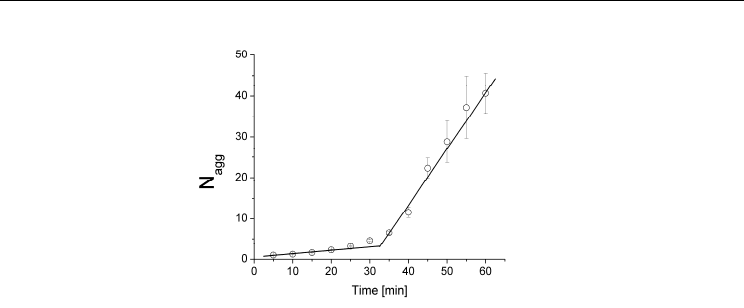
Investigating Macromolecular Complexes in Solution by Small Angle X-Ray Scattering
385
Fig. 17. Average number of monomers per aggregate as a function of time. At least two
aggregation rates can be found. The lines are just for eye guide.
The forward scattering for the native protein and the first 5 min frame at 80
o
C are almost
identical indicating that at this stage the protein is still in monomeric state. However the
differences in the scattering curve and in the p(r) functions when compared to the native
state (Fig15) indicates that the protein has adopted a different conformation. This state is
known as molten-globule which is a state where the protein is partially denaturated.
Interestingly, the protein starts to be denaturated at 80ºC, being stable over lower
temperatures (data not shown). Using equation 18, it was possible to calculate the average
number of monomers per aggregate, which is shown as a function of time in Fig 17. From
this graph, at least two aggregation rates can be identified in the graph, which might
indicates that initially the aggregation process is slow but after 30 minutes at 80ºC and with
around 5 monomers per aggregate the aggregation is accelerated reaching a number of
around 45 monomers per aggregate for 1h at 80
o
C. A visualization of the obtained
aggregates is shown in Fig 14 which agrees with above conclusions. The obtained results
confirms other results from the literature which indicates that the denaturation of the
lysozyme can be understood as one stage process (Hirai et al, 1998)
3.2 Shape and low resolution structure of extracellular hemoglobins calculated from
SAXS data
Given the inherent difficulties to obtain the crystallization of proteins with high molecular
weights, low resolution studies of extracellular hemoglobins in solution have been the main
tool of its structural studies. The physicochemical properties of extracellular hemoglobins
(erythrocruorins) have been under study since the 1930s. In particular, different oxygen
affinities and cooperativities were reported for molecules with very similar heme content,
dimensions and molecular weight. This fact has led the investigators to focus attention on
the possible structural differences that could explain this diverse functional behavior. Two
very comprehensive reviews on the structure of extracellular hemoglobins have been
published by Chung (1979) and Weber (2001). The challenge has always been the elucidation
of the interaction among the more than 200 subunits of these respiratory proteins, which
lead to the spontaneous, self-limited assembly and cooperative oxygen binding, which are
not yet completely understood. In this section the results of the study of extracellular
hemoglobins from Glossoscolex paulistus with molecular weight of ~3,100 kD will be

Current Trends in X-Ray Crystallography
386
presented. Advanced methods of shape restoration from the X-ray scattering data allowed a
description of the subunit arrangement of these molecules as well as the determination of
dimensional parameters which could also be confirmed by the results of hydrodynamic
measurements and calculations for the models proposed. There are only minor differences
in the properties already reported on the subunit structure of Lumbricus terrestris
hemoglobin (Fushitani et al., 1991) and the previous works on the structural subunits of G.
paulistus studied by pH induced and high pressure dissociation by Bonafe et al.,1991 and
Silva et al., 1989, indicating the similarity of these proteins, spite of the differences in
molecular weight.
Samples of G. paulistus were purified according to a standard procedure (Silva et al., 1989,
Bonafe et al., 1991) in several concentrations. SAXS measurements were made using
synchrotron radiation at Brazilian Synchrotron Light Laboratory, with hemoglobin in
0.05 M TRIS-HCl buffer pH 7.5. The hemoglobin concentrations used in the experiments
varied from 0.5 to 40 mg/mL and the final combination of the frames enabled the
extrapolation to zero concentration. The scattered intensities were recorded with a linear
position sensitive detector and the primary data correction was done using standard
procedures. The q range was from q = 0.005 to 0.1882 Å
-1
, with radiation wavelength of
= 1.74Å. To collect the low and high angles scattering data, two sample-detector distances
were used (1.74m and 0.84 m). The samples were kept in a 1.5 mm diameter capillary tube
sample holder, kept at a constant temperature (20ºC). Indirect Fourier Transformation was
performed using the GNOM program package. Ab initio calculations were performed
using program DAMMIN. The experimental scattered intensity was normalized to
absolute scale using water as a primary standard, which enabled the calculation of the
protein molecular weight and volume. Finally, hydrodynamic properties of molecular
models can be calculated using an approach initially developed for crystallographic
structures (program HYDROPRO, de La Torre et al., 2000), which can be easily extended
to dummy atom models when the molecular mass and partial specific volume of the
protein are known (Arndt et al., 2002). As a result, several hydrodynamic parameters can
be calculated and compared with the values obtained by other experimental methods.
This comparison can be very useful in order to check the validity of the molecular
conformation represented by the 3D models proposed.
0.00 0.05 0.10 0.15 0.20
1E-4
1E-3
0.01
0.1
1
10
Experimental Data
IFT Fit
Intensity [arb. u.]
q[Å
-1
]
0 50 100 150 200 250 300
0.00
0.05
0.10
0.15
0.20
0.25
0.30
P(R) [arb. u.]
R [Å]
Fig. 18. Scattering curve (open circles) and IFT fitting (solid line) of hemoglobin from G.
paulistus. Inset - pair distance distribution function (p(r)).
